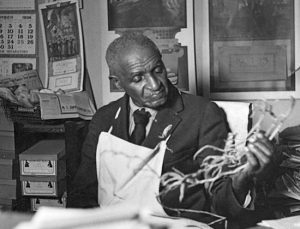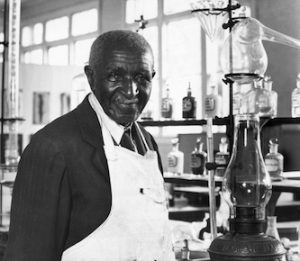TFFCM Celebrates Black History Month: The Story of George Washington Carver
George Washington Carver
In the United States of America, the month of February is Black History Month. It is a time to remember the achievements that men and women of color made throughout the history of this country. From a time of slavery to a time of freedom that did not really feel all that free, to a movement that would change the nation forever, men and women of color have played key roles in making a better quality of life for all mankind.
 Near the end of the Civil War, a child, the last of many, was born to Mary and Giles. Mary and Giles were slaves to Moses and Susan Carver in Diamond, Missouri. The date of birth for the child is unknown. The child was named George Washington and given no surname, as his father was killed before his birth. About one week after his birth, George was kidnapped, along with his sister and mother, and sold in Kentucky. Moses was able to retrieve George and bring him back to Missouri. About one year after George was born, the Civil War ended and slaves were freed. Moses and Susan chose to keep George and to educate him. Since no school nearby would accept clack children, George adopted their surname and became known to history as George Washington Carver.
Near the end of the Civil War, a child, the last of many, was born to Mary and Giles. Mary and Giles were slaves to Moses and Susan Carver in Diamond, Missouri. The date of birth for the child is unknown. The child was named George Washington and given no surname, as his father was killed before his birth. About one week after his birth, George was kidnapped, along with his sister and mother, and sold in Kentucky. Moses was able to retrieve George and bring him back to Missouri. About one year after George was born, the Civil War ended and slaves were freed. Moses and Susan chose to keep George and to educate him. Since no school nearby would accept clack children, George adopted their surname and became known to history as George Washington Carver.
George eventually received his high school diploma from Minneapolis High School in Minneapolis, Kansas. After graduating high school, George applied and was accepted into Highland College, only to be denied admittance because of his race. George then homesteaded a claim, began conducting biological experiments, and compiled a geological collection. He began taking classes at a local college. While there, his drawings caught the attention of a professor who recommended he take botany classes. George enrolled and became the first black student at Simpson College. He earned a Bachelor of Science degree from there. He then went on to receive his master’s degree at Iowa State Agricultural College.
Booker T. Washington then asked George to lead the Department of Agriculture at the Tuskegee Institute. It was during this time that George left his mark on history. George reinvigorated farming in the South! After decades of growing cotton and tobacco, the soil in the South was left depleted of needed minerals. George encouraged farmers to plant peanuts to replenish the soil. This led to an overabundance of peanuts, so George developed over 300 peanut-related products. These products included milk, chess, instant coffee, face powder, shampoo, ink, dyes, vinegar, soap, shoe polish, shaving cream, synthetic rubber, plastics, linoleum, chili sauce, flour, mayonnaise, Worcestershire sauce, and cooking oil.
 George also discovered over 100 new products from sweet potatoes, 75 from pecans, and some from Georgia clay. The exact number of products George invented is unknown because he only held three patents. Why only three? In George’s words, “God gave them to me. How can I sell them to someone else?”
George also discovered over 100 new products from sweet potatoes, 75 from pecans, and some from Georgia clay. The exact number of products George invented is unknown because he only held three patents. Why only three? In George’s words, “God gave them to me. How can I sell them to someone else?”
George had a great love for God. He saw, in everything, the hand of God. As a child, George developed a relationship with God after having another child tell him about prayer. After the conversation, George went up into the barn loft and prayed. He does not know what he said, only “that I felt so good that I prayed several times before I quit.” George was unable to enter a church for many years because of his race, but to him, Nature was God’s house. George called his lab “God’s little workshop.” George sought to share his love of science and God, which he viewed as going hand in hand, with as many as possible. As a leader at the Young Men’s Christian Association (YMCA), he encouraged young people to understand God by studying nature.
Going against the prevailing thought of the time, George did not separate science and religion. He said, “I am not interested in science or anything else that leaves God out of it.” He insisted that science proves God’s existence and was fond of quoting John 8:32, “and ye shall know the truth, and the truth shall make you free.” (KJV) To George, science was the truth and a way in which God communicates. George said, “I love to think of Nature as wireless telegraph stations through which God speaks to us every day, every hour, and every moment of our lives.”
George also credits God for his scientific discoveries and his intellect, which is the leading reason he decided against filing patents for many of his inventions. He believed that all of his inventions were divinely inspired and not from his own mind. George explained, “I never have to grope for methods: the method is revealed at the moment I am inspired to create something new.”
 George was with the Tuskegee Institute in Tuskegee, Alabama for 47 years, teaching and mentoring students. His influence went far beyond that. He revolutionized the way the South farmed. He was a missionary for God in all aspects of his life. And in a time when blacks were looked down upon, he demonstrated that it was possible to make a difference in the world. In 1939, George received the Roosevelt Medal inscribed with the words “For distinguished service in the field of science, to a scientist humbly seeking the guidance of God and a liberator of men of the white race, as well as the black.”
George was with the Tuskegee Institute in Tuskegee, Alabama for 47 years, teaching and mentoring students. His influence went far beyond that. He revolutionized the way the South farmed. He was a missionary for God in all aspects of his life. And in a time when blacks were looked down upon, he demonstrated that it was possible to make a difference in the world. In 1939, George received the Roosevelt Medal inscribed with the words “For distinguished service in the field of science, to a scientist humbly seeking the guidance of God and a liberator of men of the white race, as well as the black.”
George Washington Carver died January 5, 1943, at the age of 78 or 79. Written on his grave was “He could have added fortune to fame, but caring for neither, he found happiness and honor in being helpful to the world.”
George left behind a legacy that helped shape modern-day farming and numerous inventions still used today. But his greatest legacy was not his inventions or the awards for which he is remembered. His greatest legacy was his unwavering, indisputable faith in Christ.
For more information regarding how your financial support can help, please click here.


